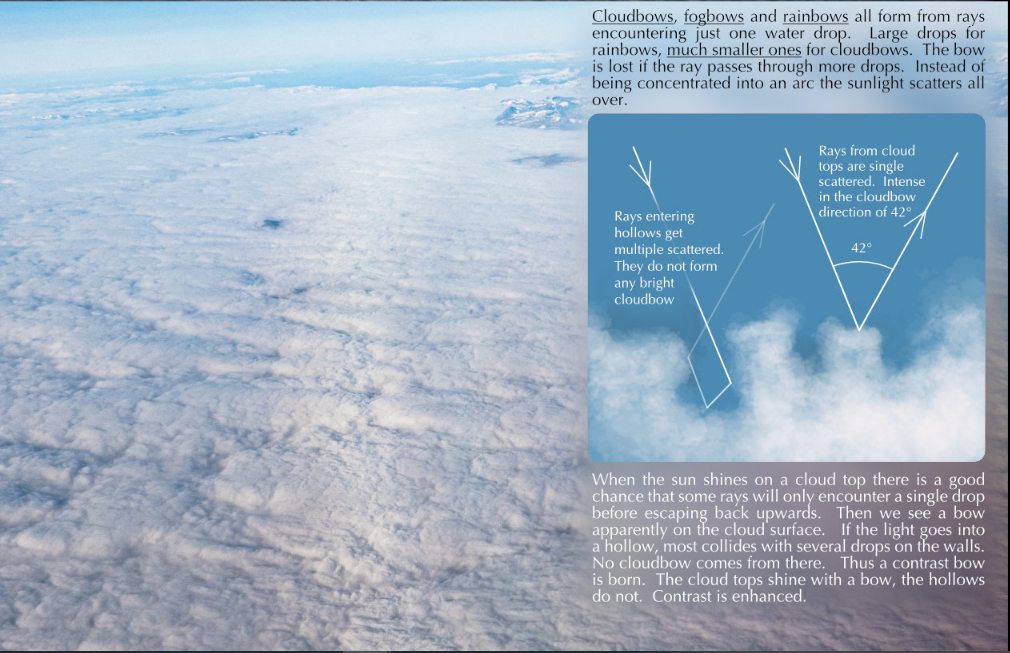Cloud Contrast Bow & Glory
Cloud Contrast Bow & Glory: A Phenomenon of Atmospheric Optics
Atmospheric optics is a fascinating field that encompasses various optical phenomena occurring in the Earth's atmosphere. One intriguing phenomenon is the Cloud Contrast Bow, which can be observed under specific conditions. In this article, we will delve into the details of this captivating optical display and explore its unique characteristics.
Understanding Cloudbows, Fogbows, and Rainbows
To grasp the concept of a Cloud Contrast Bow, it is essential to understand its relationship with other optical phenomena such as cloudbows, fogbows, and rainbows. These phenomena all occur when sunlight interacts with water droplets in the atmosphere. Rainbows form when sunlight refracts, reflects, and disperses through large water droplets, creating a colorful arc. On the other hand, cloudbows and fogbows are formed by smaller water droplets.
The Formation of a Cloud Contrast Bow
A Cloud Contrast Bow occurs when sunlight interacts with a specific type of cloud formation. When the sun shines on the top of a cloud, some rays may only encounter a single water droplet before escaping back upwards. As a result, a bow-like shape appears on the surface of the cloud, creating the Cloud Contrast Bow. However, if the light enters a hollow within the cloud, most of the rays collide with multiple water droplets on the walls, preventing the formation of a cloudbow.
Enhancing Contrast: The Role of Cloud Tops and Hollows
The unique characteristic of the Cloud Contrast Bow lies in its ability to enhance contrast between different parts of the cloud. The cloud tops, where the sunlight directly shines, exhibit a distinct bow-like shape due to the single scattering of rays. In contrast, the hollows within the cloud do not produce a cloudbow since the light collides with multiple water droplets. Consequently, this contrast in the optical display creates the striking effect of a Cloud Contrast Bow.
Exploring the Peculiar Arc
Within the Cloud Contrast Bow, a peculiar arc can be observed. This arc appears broad and almost white, and it exhibits greater contrast in the ups and downs of the cloud. Known as a 'cloud contrast bow,' this subtype of cloudbow showcases a more pronounced contrast in the cloud's features. The reason behind this phenomenon lies in the concentration of sunlight in the direction of the cloudbow, which intensifies the contrast between different areas of the cloud.
The Antisolar Point and Ringed Glory
Adjacent to the Cloud Contrast Bow, another optical phenomenon can be observed known as the ringed glory. The ringed glory marks the antisolar point, which is the point directly opposite to the sun's position. This captivating display consists of concentric rings of colors that encircle the antisolar point. The ringed glory, like the Cloud Contrast Bow, adds to the visual spectacle created by atmospheric optics.
Appreciating Atmospheric Optics
The study of atmospheric optics allows us to appreciate the intricate interplay between sunlight and various atmospheric elements. Optical phenomena like the Cloud Contrast Bow and ringed glory showcase the beauty and complexity of nature's visual displays. By understanding the underlying principles and conditions that give rise to these phenomena, we gain a deeper appreciation for the wonders of our atmosphere.
In conclusion, the Cloud Contrast Bow is an intriguing optical phenomenon that occurs when sunlight interacts with specific cloud formations. Through single scattering of rays, a distinct bow-like shape appears on the cloud tops, while hollows within the cloud do not exhibit this optical display. The contrast between these areas enhances the visual impact of the Cloud Contrast Bow. Coupled with the ringed glory marking the antisolar point, these atmospheric optics phenomena remind us of the mesmerizing beauty found within our atmosphere.

Cloud Contrast Bow
Seen over Norway by Lars Brubæk. Beneath is solid cloud. At right a ringed glory marks the antisolar point. At left a broad and almost white arc. The arc is peculiar. Where it shines the cloud ups and downs are more contrasty. A 'cloud contrast bow', a subtype of a cloudbow.

Cloudbows, fogbows and rainbows all form from rays encountering just one water drop. Large drops for rainbows, much smaller ones for cloudbows. The bow is lost if the ray passes through more drops. Instead of being concentrated into an arc the sunlight scatters all over.
Rays entering hollows get multiple scattered. They do not form any bright cloudbow
Rays from cloud tops are single scattered. Intense in the cloudbow direction of 42°
When the sun shines on a cloud top there is a good chance that some rays will only encounter a single drop before escaping back upwards. Then we see a bow apparently on the cloud' surface. If the light goes into a hollow, most collides with several drops on the walls. No cloudbow comes from there. Thus a contrast bow is born. The cloud tops shine with a bow, the hollows do not. Contrast is enhanced.
Note: this article has been automatically converted from the old site and may not appear as intended. You can find the original article here.
Reference Atmospheric Optics
If you use any of the definitions, information, or data presented on Atmospheric Optics, please copy the link or reference below to properly credit us as the reference source. Thank you!
-
<a href="https://atoptics.co.uk/blog/cloud-contrast-bow-glory/">Cloud Contrast Bow & Glory </a>
-
"Cloud Contrast Bow & Glory ". Atmospheric Optics. Accessed on November 26, 2024. https://atoptics.co.uk/blog/cloud-contrast-bow-glory/.
-
"Cloud Contrast Bow & Glory ". Atmospheric Optics, https://atoptics.co.uk/blog/cloud-contrast-bow-glory/. Accessed 26 November, 2024
-
Cloud Contrast Bow & Glory . Atmospheric Optics. Retrieved from https://atoptics.co.uk/blog/cloud-contrast-bow-glory/.